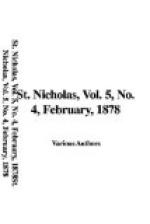You have done so well already, Willie, that we think you can best answer your own question; but we should take all of our best pigeons.
* * * * *
New York.
Will ST. NICHOLAS please tell
“Sidonie” if the “trade dollar”
is
made entirely of silver?
It is not. There are 900 parts of pure silver and 100 parts of copper in the “trade dollar.” The copper alloy is added to make the coin hard, so that it will wear well, as silver by itself would be too soft.
* * * * *
Chicago, Ill.
DEAR ST. NICHOLAS: I, for one, think it is all nonsense about those “that” sentences. Anybody can put more than eight “thats” in a sentence; but if he, she, or it, can parse them, I would like to have them do it. I don’t believe it can be done. Let them parse the sentence in the August number, for instance; and, if they can put in twelve “thats” and then parse them, why, then, and not till then, will I believe it. Please put this in the Letter-Box, and oblige.
C.P.S.
* * * * *
Louisville, Ky.
DEAR ST. NICHOLAS: I thank you very much for the many beautiful designs which you have given for Christmas presents, and for the pictures and silhouettes which you have published, from which we have copied in tableaux vivants and shadow pantomimes. We had “The Modern and Mediaeval Ballad of Mary Jane” (published in January, 1877) in our church entertainment, and it “took” immensely. “The Stalwart Benjamin” and “Lord Mortimer” were cut from pasteboard, and fastened up by wires, and, of course, no one knew that they were not people. The “Ballad” was read behind the scenes.—Truly yours,
KITTY B. WHIPPLE.
* * * * *
Boston.
DEAR ST. NICHOLAS: Papa has bought me every number of the ST. NICHOLAS you have ever published, and as I have seen several letters asking you about different things, I thought I would ask you about something I do not understand. If it is not really known who wrote the plays “Titus Andronicus” and “Pericles, Prince of Tyre,” what circumstances lead people to think Shakspeare wrote them?
I have enjoyed you extremely,
and as the Little Schoolma’am seems
always to answer such questions,
I write to you hoping you will ask
her.—I am your
fond admirer,
ETHEL DAVIS.
The Little Schoolma’am says it is not absolutely certain who wrote the plays you name, but this is about the way the matter stands:
The play “Titus Andronicus” is not now believed to have been originally written by Shakspeare. It is considered too horrible and repulsive to be his work. However, it may have been brought to him to be retouched and made ready for the stage. Hence is it, perhaps, that some passages of his are found in it.




